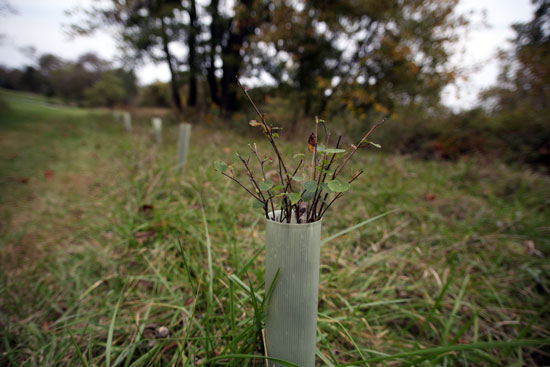Linking land and water in brook trout conservation
The Bay Program is using brook trout to promote land conservation and habitat restoration in headwater states.
In rural West Virginia, a fisherman casts his bright green line into a mountain stream. The stream is clear, the fish are biting and it takes just minutes to make a catch.
Dustin Wichterman, Potomac Headwaters Project Coordinator with Trout Unlimited, dips his net into the water and reveals a 10-inch brook trout. Its olive green body is flecked with red and gold, and its mere presence here is a welcome sign of health for the Pendleton County waterway.

Native to the headwaters of the Chesapeake Bay, the eastern brook trout is a sensitive species that needs cold, clean water to survive. But as regional water quality has declined, so, too, have brook trout populations, leading to lost revenue and diminished fishing opportunities for headwater states.
Brook trout play a critical role in the watershed: they are an important part of the region’s natural heritage, a driver of economic growth and an indicator of environmental health. For these reasons, brook trout restoration was a listed outcome in the federal Strategy for Protecting and Restoring the Bay Watershed. And for the past two years, brook trout conservation has been a top goal for the Chesapeake Bay Program.
Through the Bay Program’s Habitat Goal Implementation Team, whose members work to protect and restore wetlands, woods and other habitats across the watershed, brook trout have benefited from stream restoration, fish passage renewal and tree plantings.
As odd as it might seem, the health of a fish depends not just on the health of the creek, stream or river that it calls home; it is also tied to the health of the surrounding land. And poor land management, increasing development and expanding urbanization have been cited as leading factors in brook trout decline.
“This fish is a living symbol of how actions on land affect the health of our local waterways,” said team coordinator Jennifer Greiner.
The removal of streamside trees, for instance, is a common consequence of agricultural or residential development, as seedlings are trampled by grazing cattle or trees are felled for suburban growth. But a missing forest buffer means bad news for brook trout when stream banks erode, excess sediment ruins spawning beds and an absence of shade pushes water temperatures into a range that brook trout cannot withstand.
When, on the other hand, trees and shrubs are allowed to grow along waterways, their runoff-trapping roots keep the water clean and their shade-producing leaves keep the water cold.

So Greiner and her fellow team members have worked to bring brook trout into the land-use discussion, pushing the latest brook trout distribution data out to doers and decision-makers in the watershed. Because when land managers know where brook trout are, they are more likely to take the fish into account in land-use decisions.
Land trusts in headwater states have also found that brook trout can push private landowners to conserve, and Goal Implementation Team partners—the U.S. Fish and Wildlife Service, the Natural Resources Conservation Service, the National Fish and Wildlife Foundation and the Eastern Brook Trout Joint Venture Partnership among them—are using the iconic fish to promote on-the-ground restoration of riparian forest buffers.
Whether a farmer installs a fence that keeps livestock out of local rivers or a landowner decides to plant a series of streamside trees, education and engagement are critical to conservation.
“By becoming educated and engaged, landowners are able to protect the streams on their land for future generations,” Greiner said. “By protecting and restoring stream habitat, the brook trout, along with other species, are also protected for future generations to enjoy.”

Comments
There are no comments.
Thank you!
Your comment has been received. Before it can be published, the comment will be reviewed by our team to ensure it adheres with our rules of engagement.
Back to recent stories